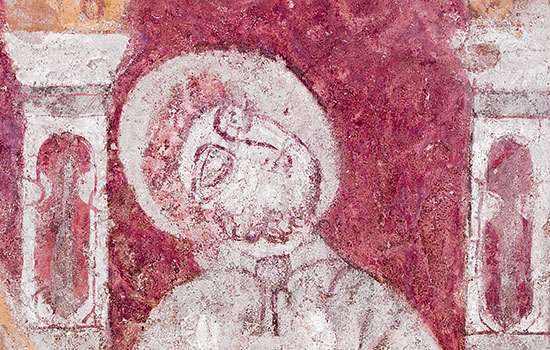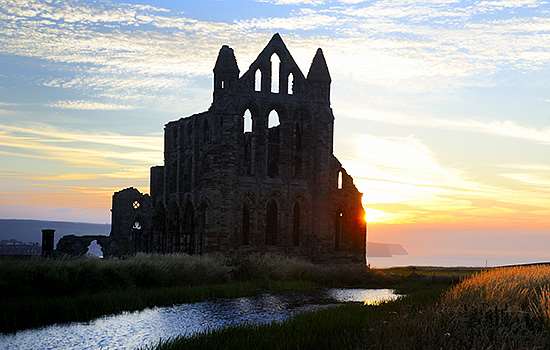The church
Built around 1130, this tiny church is an extraordinary survival from the Norman world. Its exceptional decoration is owed to the patronage of one of the wealthiest early Norman families in England, the de Lacys.
Walter de Lacy had fought with William the Conqueror at the battle of Hastings and owned large stretches of the Welsh marches. Kempley was in de Lacy hands in the late 11th and 12th centuries. After Walter died in 1085 his body was taken from Hereford to Gloucester for burial, and may have rested briefly at Kempley. His son Hugh may have built St Mary’s to commemorate this.
St Mary’s probably replaced an earlier Saxon church on this site, and retains a simple ‘Saxon’ layout, with a rectangular chancel and an aisleless nave. The tower, blocking the church’s west entrance, was added in about 1276 during Edward I’s wars in Wales. The timber-framed porch dates to the 14th century.
The wall paintings
Medieval church paintings were used to educate and inspire a congregation who may not have understood the Latin church services. They taught a Christian understanding of the world, offered moral guidance, and aroused the emotions. The artists at St Mary’s used the nave – the main body of the church – to depict more earthly subjects, while the chancel (the east end, where the altar stood) was conceived as Heaven, and shows a vision of Christ at the Apocalypse.
The first artists at St Mary’s were working in the newly built church, around 1130. They painted onto fresh lime plaster (fresco technique) and added other details when the plaster was dry (secco technique). They also painted directly onto the stonework.
Other painting schemes were added in the late 14th and 15th centuries. Later, with the hostility to religious art during the Reformation, the paintings were hidden behind whitewash. They were only rediscovered in 1872.
Scroll through the images below to see scenes from the wall paintings.
Help us conserve these wall paintingsMedieval timber
Tree-ring dating has revealed that St Mary’s still has its original Norman roof and doors.
In the 1990s tree-ring dating was carried out on timbers from the church roof, which was hidden above the 17th-century ceiling in the nave. This revealed that St Mary’s roof was built in the early 12th century, making it the earliest and most complete Norman timber roof known in Britain. Unlike later medieval roofs, its 16 roof trusses were held together with collars (horizontal beams) and struts, rather than tie-beams spanning from wall to wall.
The west door into the tower is one of the earliest doors still in use in England. It was originally an external door, but the building of the tower in the 13th century has helped to protect it from the elements. The timber used for it was felled between 1114 and 1141, and all the planks were cut from a single tree. The parish chest in the tower is later, and has been dated between 1492 and 1522. Used to store villagers’ valuables, it is simply constructed from a hollowed-out oak log with an elm lid.
Image: the 12th-century timber door between the nave and the west tower
Further reading
Gethyn-Jones, JE, St Mary’s Church, Kempley, and Its Paintings, vol 1 (Gloucester, 1961)
Morley, BM, ‘The nave roof of the church of St Mary, Kempley, Gloucestershire’, Antiquaries Journal, 65 (1985), 101–11
Find out more
-

Visit St Mary’s Kempley
Plan your visit to St Mary’s Kempley to see the spectacular wall paintings at this tiny church for yourself.
-

Download the audio tour
Download this short audio tour to find out more about the significance of the wall paintings, and how St Mary’s ancient timbers were dated.
-

Medieval Religion
Find out more about the importance of religion in the Middle Ages, when the Church was a pervasive force in people’s lives.
-

MORE HISTORIES
Delve into our history pages to discover more about our sites, how they have changed over time, and who made them what they are today.




















